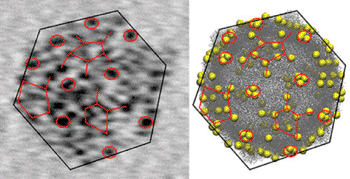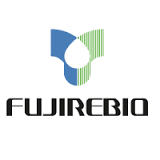Gold Nanoparticles Designed to Track Viruses
By LabMedica International staff writers
Posted on 30 Jan 2014
Finish scientists have developed a unique strategy for the study of Enterovirus structures and their biologic processes. The new approach will help in obtaining new data on viruses functioning in cells and tissues as well as on the mechanisms of virus opening inside cells. This new information will be important, for instance, for developing new antiviral drugs and vaccines. Posted on 30 Jan 2014
The study’s findings were published January 13, 2014, in the journal Proceedings of the National Academy of Sciences of the United States of America (PNAS). The research, conducted by researchers at the Nanoscience Center (NSC) of the University of Jyväskylä (Finland), was funded by the Academy of Finland (Helsinki) and Tekes’ (Länsi-Pasila, Finland) FiDiPro project NOVAC (Novel Methods for Vaccination and Virus Detection).

Image: Transmission electron microscopy (TEM) image of a single CVB3 virus showing tens of gold nanoparticles attached to its surface (left). The particles form a distinct “tagging pattern” that reflects the shape and the structure of the virus. The TEM image can be correlated to the model of the virus (right), where the yellow spheres mark the possible binding sites of the gold particles. The diameter of the virus is about 35 nm (Photo courtesy of PNAS - Proceedings of the National Academy of Sciences of the United States of America).
The infection mechanisms and infectious pathways of enteroviruses are still rather poorly known. Earlier research from the group of NSC’s Dr. Varpu Marjomäki have centered on the cellular factors that are important for the infection caused by selected enteroviruses. The understanding of virus processes of opening and releasing the viral genome in cellular structures for starting new virus production is still mostly unknown. Moreover, the knowledge of infectious processes in tissues is restricted by the lack of effective tools for detecting virus infections.
The newly developed technique involves a chemical modification of a known thiol-stabilized gold nanoparticle, the so-called Au102 cluster, which was first synthesized and structurally deciphered by Dr. Roger D. Kornberg’s team, from Stanford University (Stanford, CA, USA), in 2007 and later characterized at the NSC by the groups of Prof. Hannu Häkkinen and Prof. Mika Pettersson in collaboration with Dr. Kornberg.
The organic thiol surface of the Au102 particles is modified by attaching linker molecules that make a chemical bond to sulfur-containing cysteine residues that are part of the surface structure of the virus. Several tens of gold particles can bind to a single virus, and the binding pattern looks like dark tags reflecting the overall shape and structure of the virus. The gold particles allow for studies on the structural changes of the viruses during their lifespan.
In addition, the study’s findings revealed that the viruses’ infection approach is not compromised by the attached gold particles, which indicates that the labelling strategy does not interfere with the normal biologic functions of viruses inside cells. This aids new research on the virus structures from samples gathered from inside cells during the various phases of the virus infection, and makes it possible to obtain new information on the mechanisms of virus uncoating.
The new technique, according to the researchers, also allows for tracking studies of virus pathways in tissues. This is significant for the further determination of acute and chronic symptoms caused by viruses. Finally, the method is expected to be useful for developing new antiviral vaccines based on virus-like particles.
The method was developed at the NSC as a wide, cross-disciplinary collaboration between physicists, chemists, and biologists.
Related Links:
University of Jyväskylä














